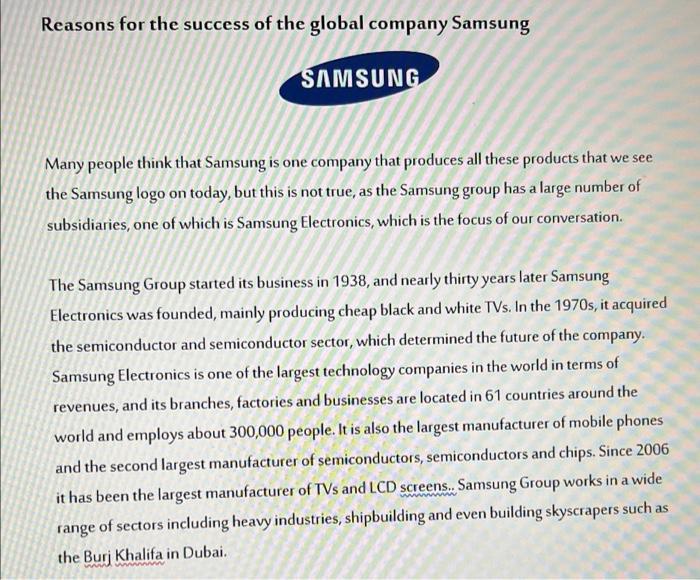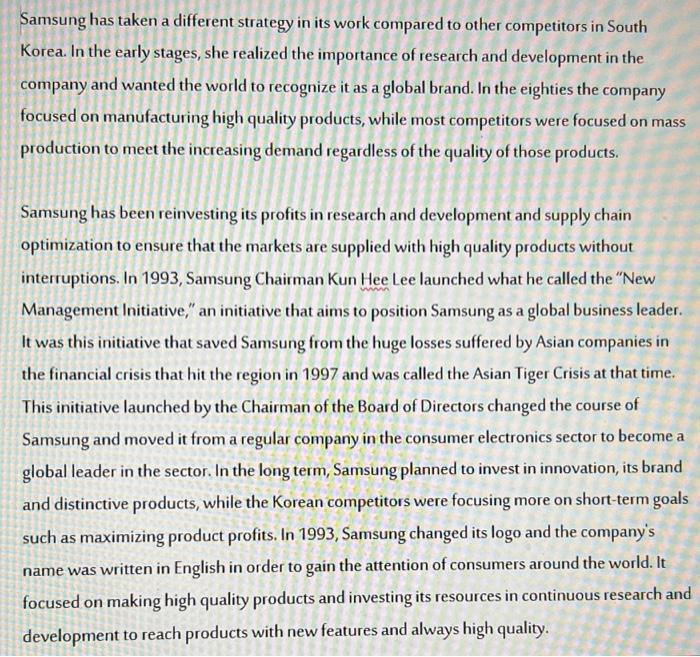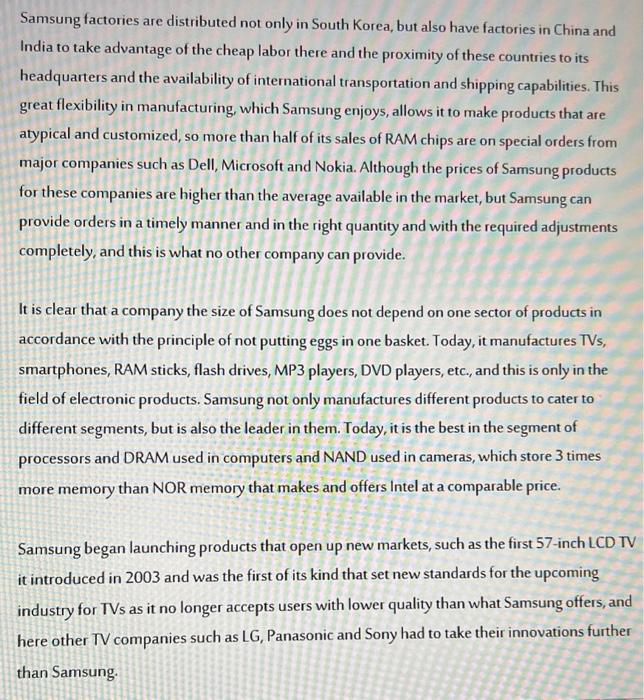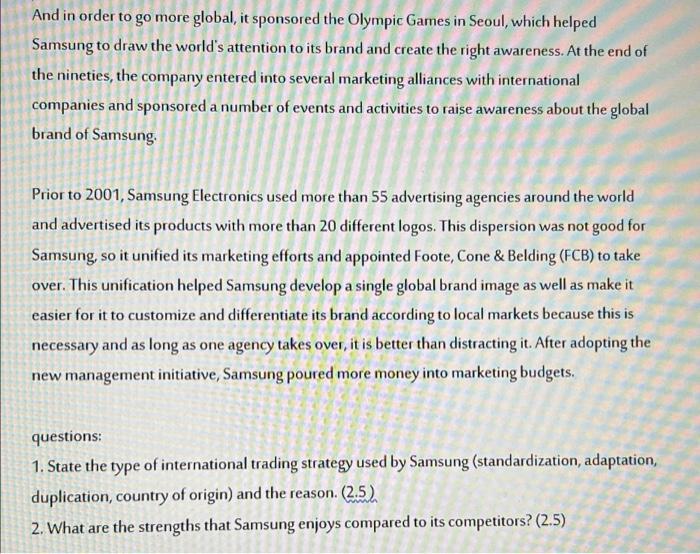Answered step by step
Verified Expert Solution
Question
1 Approved Answer
Reasons for the success of the global company Samsung SAMSUNG Many people think that Samsung is one company that produces all these products that





Reasons for the success of the global company Samsung SAMSUNG Many people think that Samsung is one company that produces all these products that we see the Samsung logo on today, but this is not true, as the Samsung group has a large number of subsidiaries, one of which is Samsung Electronics, which is the focus of our conversation. The Samsung Group started its business in 1938, and nearly thirty years later Samsung Electronics was founded, mainly producing cheap black and white TVs. In the 1970s, it acquired the semiconductor and semiconductor sector, which determined the future of the company. Samsung Electronics is one of the largest technology companies in the world in terms of revenues, and its branches, factories and businesses are located in 61 countries around the world and employs about 300,000 people. It is also the largest manufacturer of mobile phones and the second largest manufacturer of semiconductors, semiconductors and chips. Since 2006 it has been the largest manufacturer of TVs and LCD screens.. Samsung Group works in a wide range of sectors including heavy industries, shipbuilding and even building skyscrapers such as the Burj Khalifa in Dubai. www Samsung has taken a different strategy in its work compared to other competitors in South Korea. In the early stages, she realized the importance of research and development in the company and wanted the world to recognize it as a global brand. In the eighties the company focused on manufacturing high quality products, while most competitors were focused on mass production to meet the increasing demand regardless of the quality of those products. www Samsung has been reinvesting its profits in research and development and supply chain optimization to ensure that the markets are supplied with high quality products without interruptions. In 1993, Samsung Chairman Kun Hee Lee launched what he called the "New Management Initiative," an initiative that aims to position Samsung as a global business leader. It was this initiative that saved Samsung from the huge losses suffered by Asian companies in the financial crisis that hit the region in 1997 and was called the Asian Tiger Crisis at that time. This initiative launched by the Chairman of the Board of Directors changed the course of Samsung and moved it from a regular company in the consumer electronics sector to become a global leader in the sector. In the long term, Samsung planned to invest in innovation, its brand and distinctive products, while the Korean competitors were focusing more on short-term goals such as maximizing product profits. In 1993, Samsung changed its logo and the company's name was written in English in order to gain the attention of consumers around the world. It focused on making high quality products and investing its resources in continuous research and development to reach products with new features and always high quality. Samsung factories are distributed not only in South Korea, but also have factories in China and India to take advantage of the cheap labor there and the proximity of these countries to its headquarters and the availability of international transportation and shipping capabilities. This great flexibility in manufacturing, which Samsung enjoys, allows it to make products that are atypical and customized, so more than half of its sales of RAM chips are on special orders from major companies such as Dell, Microsoft and Nokia. Although the prices of Samsung products for these companies are higher than the average available in the market, but Samsung can provide orders in a timely manner and in the right quantity and with the required adjustments completely, and this is what no other company can provide. It is clear that a company the size of Samsung does not depend on one sector of products in accordance with the principle of not putting eggs in one basket. Today, it manufactures TVs, smartphones, RAM sticks, flash drives, MP3 players, DVD players, etc., and this is only in the field of electronic products. Samsung not only manufactures different products to cater to different segments, but is also the leader in them. Today, it is the best in the segment of processors and DRAM used in computers and NAND used in cameras, which store 3 times more memory than NOR memory that makes and offers Intel at a comparable price. Samsung began launching products that open up new markets, such as the first 57-inch LCD TV it introduced in 2003 and was the first of its kind that set new standards for the upcoming industry for TVs as it no longer accepts users with lower quality than what Samsung offers, and here other TV companies such as LG, Panasonic and Sony had to take their innovations further than Samsung. Not only did Samsung set new industry standards, it was bringing new products to market twice as fast as other competitors. With this high rate of launching new products to the market, Samsung aims to lower the prices of its old products, thus putting pressure on competitors and their products with a price force, making it gain a larger market share. According to this competitive strategy, other companies find themselves losing their focus from developing their products to catching up with Samsung and responding to their products, thus gradually losing their position in the market. Samsung has the lowest level of bureaucracy and red tape despite its huge size that spans the world. The company activates and volunteers technology to speed up the decision-making process at various administrative levels. Prior to the adoption of the new management initiative, Samsung did not have sufficient vision for the appropriate marketing of the company and its products, and product managers were controlling marketing budgets, always spending less than normal limits and designing their marketing strategies to achieve short-term goals. In order to move Samsung from "a company that makes cheap hardware" to "a company that provides high value-added products", Samsung had to develop its brand significantly, so it was necessary to focus on effective marketing. In 1999, he began emphasizing the importance of looking at the Samsung brand An essential and vital part of the company is no less important than the factories and experiences, and therefore it should have established the global Samsung brand, not the Korean Samsung brand. And in order to go more global, it sponsored the Olympic Games in Seoul, which helped Samsung to draw the world's attention to its brand and create the right awareness. At the end of the nineties, the company entered into several marketing alliances with international companies and sponsored a number of events and activities to raise awareness about the global brand of Samsung. Prior to 2001, Samsung Electronics used more than 55 advertising agencies around the world and advertised its products with more than 20 different logos. This dispersion was not good for Samsung, so it unified its marketing efforts and appointed Foote, Cone & Belding (FCB) to take over. This unification helped Samsung develop a single global brand image as well as make it easier for it to customize and differentiate its brand according to local markets because this is necessary and as long as one agency takes over, it is better than distracting it. After adopting the new management initiative, Samsung poured more money into marketing budgets. questions: 1. State the type of international trading strategy used by Samsung (standardization, adaptation, duplication, country of origin) and the reason. (2.5) 2. What are the strengths that Samsung enjoys compared to its competitors? (2.5)
Step by Step Solution
★★★★★
3.42 Rating (149 Votes )
There are 3 Steps involved in it
Step: 1
Ans Lets understand the same step by step please upvote for the efforts International trading system used by Samsung Samsung uses the below trading sy...
Get Instant Access to Expert-Tailored Solutions
See step-by-step solutions with expert insights and AI powered tools for academic success
Step: 2

Step: 3

Ace Your Homework with AI
Get the answers you need in no time with our AI-driven, step-by-step assistance
Get Started


